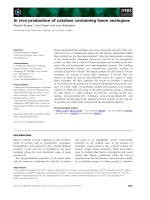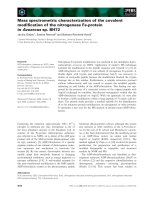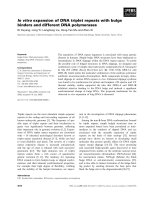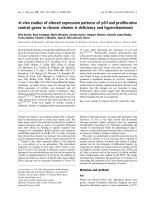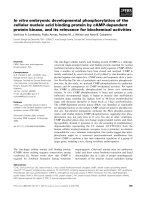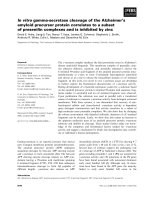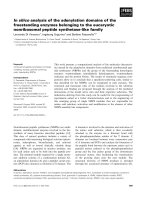Báo cáo khoa học: "In vitro characterization of cells derived from chordoma cell line U-CH1 following treatment with X-rays, heavy ions and chemotherapeutic drugs" pdf
Bạn đang xem bản rút gọn của tài liệu. Xem và tải ngay bản đầy đủ của tài liệu tại đây (609.02 KB, 9 trang )
RESEARCH Open Access
In vitro characterization of cells derived from
chordoma cell line U-CH1 following treatment
with X-rays, heavy ions and chemotherapeutic
drugs
Takamitsu A Kato
1,2,3
, Akihisa Tsuda
1,2,4
, Mitsuru Uesaka
4
, Akira Fujimori
1,2
, Tadashi Kamada
1
, Hirohiko Tsujii
1
and
Ryuichi Okayasu
1,2*
Abstract
Background: Chordoma, a rare cancer, is usually treated with surgery and/or radiation. However, very limited
characterizations of chordoma cells are available due to a minimal availability (only two lines validated by now)
and the extremely long doubling time. In order to overcome this situation, we successfully derived a cell line with
a shorter doubling time from the first validated chordoma line U-CH1 and obtained invaluable cell biological data.
Method: After isolating a subpopulation of U-CH1 cells with a short doubling time (U-CH1-N), cell growth, cell
cycle distribution, DNA content, chromosome number, p53 status, and cell survival were examined after exposure
to X-rays, heavy ions, camptothecin, mitomycin C, cisplatin and bleocin. These data were compared with those of
HeLa (cervical cancer) and U87-MG (glioblastoma) cells.
Results: The cell doubling times for HeLa, U87-MG and U-CH1-N were approximately 18 h, 24 h and 3 days
respectively. Heavy ion irradiation resulted in more efficient cell killing than x-rays in all three cell lines. Relative
biological effectiveness (RBE) at 10% survival for U-CH1-N was about 2.45 for 70 keV/μm carbon and 3.86 for 200
keV/μm iron ions. Of the four chemicals, bleocin showed the most marked cytotoxic effect on U-CH1-N.
Conclusion: Our data provide the first comprehensive cellular characterization using cells of chordoma origin and
furnish the biological basis for successful clinical results of chordoma treatment by heavy ions.
Background
Chordoma is a rare malignant bone tumor accounting for
only 1 to 4% of all primary malig nant bone tumors [1].
Chordoma originates from notochordal remnants and
has slower local growth and metastasizes less frequently
than other bone and soft tissue malignant tumors [2].
Chordoma is not easy to control because of its anatomic
location and propensity for spreading extensively. Com-
plete radical resection produces better local control com-
pared with subtotal resection and chemotherapy [1,2].
Some case studies reported that photon, proton, and
charged particle carbon radiotherapy may delay possible
recurrence after incomplete resection and may also be
able to control the tumor [3-13]. A phase II study of 9-
nitro-camptothecin in patients with advanced chordoma
showed that it possessed modest activity in delaying pro-
gression with unresectable or metastatic ch ordo ma [14].
Several reports suggested that PI3K/AKT/T SC1/TSC2/
mTOR pathway and EGFR are potential therapeutic tar-
gets for chordoma [15,16]. One report showed that the
combination with topoisomerase II inhibitor razoxane
enhances the effectiveness of chordoma radiotherapy
[17].
It is sometimes difficult to perform complete radical
resection of chordoma tumors, depending on anatomic
location or grade of tumor spreading. Because of the
lower effectiveness of chemotherapy, radiotherapy is a
useful treatment tool, and thus information on cellular
* Correspondence:
1
Research Center for Charged Particle Therapy, National Institute of
Radiological Sciences, 4-9-1 Anagawa, Inage-ku, Chiba-shi, 263-8555 Japan
Full list of author information is available at the end of the article
Kato et al. Radiation Oncology 2011, 6:116
/>© 2011 Kato et al; licensee BioMed Central Ltd. This is an Open Access article distributed under the terms of the Creative Commons
Attribu tion License ( which permits unrestricted use, distribution, and reproduction in
any medium, provided the original work is properly cited.
radiosensitivities to photon and/or charged particles i s
urgently needed.
Despite the accumulation of data from the clinical
side, there is a scarcity of information from the biology
side because of the difficulty in obtaining basic cell bio-
logical data from the two currently available chordoma
lines; the first cell line has been available for the last few
years and the second one became available from the
Chordoma foundation a few month ago. Another big
obstacle is extremely long doubling time of chordoma
cells. The first validated chordoma cell line, U-CH1, iso-
lated by a German group, presented a long cell doubling
time (~ 7 days) and chromosome instability and rearran-
gement [18]. U-CH1-N, a subpopulation derived from
U-CH1 chordoma cells at National Institute of Radiolo-
gical Sciences (NIRS), has acceptably shorter cell dou-
bling time that enabled us to carry out in vitro cell
biological research such as clonogenic cell survival
assay. This study is the first to report the measurement
of in vitro cellular radiosensitivity, heavy ion biological
effectiveness, and responses to chemotherapy agen ts for
a sacral chordoma cell line.
Methods
Cell lines and culture conditions
ThechordomacelllineU-CH1waskindlysuppliedby
the Chordoma Foundation in Greensboro, NC, USA.
U87-MG and HeLa cell lines were obtained from
ATCC, USA. Cells were cultured in MEM-alpha (Gibco,
Japan) supplemented with 10% fetal bovine serum (FBS,
Sigma, Japan) and 1% antibiotics and a ntimicotics
(Gibco, Japan), and they were maintained at 37°C in a
humidified atmosphere of 5% CO
2
in air.
U-CH1-N cells and cell doubling time
Original U-CH1 cells had 7 days of doubling time in
Iscove/RPMI (4:1) medium with 10% FBS in collagen-
coated flasks [18]. In order to perform clonogeni c colony
formation assay, at least 7 cell divisions are required to
obtain colony containing more than 50 cells. If we use
the original U-CH1, it will take at least 2 months to get
countable colonies. Therefore, we adapted U-CH1 in
alpha-MEM medium supple mented with 10% FBS under
normal culture conditions in tissue culture plastic flasks,
similar to the other two cell lines. After three weeks we
isolated fast growing subpopulation of U-CH1, and desig-
nated as “U-CH1-N” (N for NIRS). To mea sure the c ell
doubling time, cells were seeded at 5000 cells per T12.5
flask, and their number was counted at regular intervals.
Comparison of parental and subpopulation of U-CH1,
chromosome and p53 analysis
U-CH1-N cells were verified for their charact eristics on
karyotyping compared with their original U-CH1 cells.
U-CH1-N cells were cultured with 0.1 μg/ ml Colcemid
for 6 hours to harvest metaphase chromosomes. Sam-
ples were treated in hypotonic solution, 75 mM KCl, for
20 min at 37°C and fixed in 3:1 (methanol: acetic acid)
fixation solution three times. Spread metaphase chromo-
somes were stained with Giemsa solution, and the chro-
mosome number was observed under a microscope.
Genomic DNA from parental U-CH1 and faster grow-
ing subpopulation U-CH1-N was isolated with Qiagen
Blood & Cell Culture DNA mini kit (Qiagen, Japan).
The genomic regions of the p53 gene we re amplified by
PCR using KOD plus polymerase (TOYOBO, Japan)
with the following primers: hTP53AF (5’ -
ccattcttttcctgctc cacaggaagccga-3’ )andhTP53BR(5’ -
ggctaagctatgatgttccttagattaggt-3’ ) for exons 2 - 9,
hTP53CF (5’ -ctgtataggtacttgaagtgcagtttctac -3’ )and
hTP53CR (5’ -ttgtaaactaacccttaactgcaagaac at -3’)for
exons 10 and 11. The conditions of PCR were: 94°C, 2
min, 35 cycles of 94°C (15 sec) and 68°C (4 min). The
amplified DNA f ragments (approximate 3.6 kb and 1.5
kb) were subjected to sequencing reaction using the p53
exon-specific primers supplied by Nippon Gene
(Toyama, Japan) and Big-Dye Terminator Cycle Sequen-
cing FS Ready Reaction Kit V3.1 (Applied B iosystems,
Foster City, CA). The nucleotide sequence was evaluated
by genetic analyzer PRISM 310 (Applied Biosystems)
and verified on both s trands. The nucleotide sequence
data of TP53 determined in the present study were
deposited to DDBJ/EMBL/Genbank as a following acces-
sion ID; AB511810.
Flow cytometry
Randomly dividing sample cultures were fixed in 70%
ethanol and kept at -20°C until analysis. PI-stained
10,000 cells were analyzed by BD FACSCalibur (Beckton
Dickinson, Japan) to obtain the DNA content histogram.
Cell cycle characteristics were analyzed by Modfit pro-
gram on Mac OS 9. The DNA content was compared
with Chinese Hamster Ovary cells that have diploid
DNA c ontent and were calculated a s 50 as an arbitrary
unit.
Irradiation and chemical treatment for Colony formation
assay
Cells were irradiated with TITAN x-ray irradiator with
200 kVp, 20 mA, 0.5 cm of Al and Cu filter (Shimadzu,
Japan). H eavy ion treatment was performed by HIMAC
(Heavy Ion Medical Accelerator in Chiba). The acceler-
ated ions used in this study were carbon ions (290
MeV/n), neon (400 MeV/n), silicon (490 MeV/n), argon
(500 MeV/n), and iron ions (500 MeV/n). The details
concerning the beam characteristics of carbon-ion
beams, biological irradiation procedures, and dosimetry
have been described elsewhere [19,20]. We used several
Kato et al. Radiation Oncology 2011, 6:116
/>Page 2 of 9
kinds of beams having different LET values, using Lucite
abso rbers with various thicknesses to change the energy
of the beams. At the sample position, we estimated the
LET val ues of carbon (13, 30, 50, 70 keV/μm), neon (31,
70, 120 keV/μm), silicon (55, 150, 250 keV/μm), argon
(100 keV/μm), and iron (200 keV/μm). Taking fragmen-
tations into consideration, dose was calculated from flu-
ence [21-23]. Asynchronously dividing cells cultured in
T12.5 flasks were irradiated at room temperature. For
chemical treatment, cycling cells in T12.5 cultu re flasks
were exposed to series of concentration of bleocin, a
single component of bleomycin family group A (Calbio-
chem , Japan), which induces DNA strand breaks, camp-
tothecin (CPT, Sigma, Japan) which is a Topoisomerase
I inhibitor, mitomycin C (MMC, Funakoshi, Japan)
which induces DNA crosslink, or cisplatin (Nippon
Kayaku, Japan) which induces DNA crosslink for 1 hour
at 37°C.
After exposure to ionizing radiation or chemical treat-
ment, cells were trypsinized and re-plated in P-100 cell
culture dishes. HeLa and U87-MG cells were cultured
for 10 to 14 days, and U-CH1-N cells were kept in an
incuba tor for 3 to 4 weeks. Plating efficiency of U-CH1-
N,U87-MG,andHeLacellswere4.8%,32%,and70%,
respectively. After colonies were formed, cells were fixed
with 100% ethanol and stained with crystal violet solu-
tion. Colonies were observed under microscope and
colonies containing more than 50 cells were counted as
survivors. Cell survival assay was carried out 2 to 4
times independently. Radiation exposed cell survival
curves were fitted with linear quadratic model by
PRISM5 software on MacOSX10.6. Error bars indicate
standard error of the means.
Results
Cellular doubling time, chromosome number, and p53
status of U-CH1-N
The original U-CH1 cell line had a 7-day doubling time
under culture medium and conditions originally used.
We used the identical cell culture conditions for all
three different tumor cell lines to avoid complexities
arising from different growth conditions among them.
The doubling time for U-CH1-N derived from U-CH1
at NIRS was about three days as against 7 days for the
parental U-CH1 cell line. This reduced doubling time is
still significantly longer than 21.5 hours for U87-MG
and 18 hours for HeLa cells (Figure 1A). This shortened
doubling time for U-CH1-N enabled us to carry out
essential in vitro experiments including the colony for-
mation assay to determine cell survival fraction against
ionizing radiation and anti-tumor chemicals.
Our chromosome analysis of U-CH1-N cells showed
that the distribution of chromosome numbers are prac-
tically identical to the numbers measured for the
original U-CH1 cells (Figure 1B) [18]. Original U-CH1
had 75 chromosomes per cell on average, and our U-
CH1-N cells averaged 75.34 chromosomes per cell.
The DNA sequencing data of the p53 gene of U-CH1-
N was compared with the human wild-type TP53 gene
MM_000546. It was revealed th at one allele of p53 had
a mutation carrying a C > G substitution a t nucleotide
residue 412 within exon 4, converting the corresponding
amino acid from proline to arginine (Figure 1C). Paren-
tal U-CH1 carried exactly the same heterozygous muta-
tion in p53 gene.
Cell Cycle Distribution and DNA Content
Both cell cycle distribution and DNA profile were mea-
sured by a flow cytometer. The results are summarized
in Table 1. DNA profile showed that U-CH1-N and
HeLa were near tetraploid (about 100 and 90, respec-
tively) compared with almost normal diploid DNA con-
tent (about 60) of U87-MG. Cell cycle distribution in
chordoma cells showed a significantly high ratio in G1-
phase, very different from the DNA profile patterns of
the other two cell lines. These showed a greater number
of cells in G1-phase (75%) and a smaller number in S-
phase (13.3%). The slow growth speed of U-C H1-N may
have a relationship with the long resting time before
DNA synthesis in G1-phase.
Cellular Radiosensitivity and Relative Biological
Effectiveness
Asynchronous cell cultures were irradiated with various
kinds of ionizing radiations (X-rays, carbon-ions 13
keV/μ m, carbon-ions 70 keV/μ m, iron-ions 200 keV/
μm). Because of long cellular doubling time, the colony
size of U-CH1-N was generally smaller than HeLa and
U87 cells, even when a longer incubation time was
allowed to f orm colonies. Nevertheless, by the time of
fixation, we were able to observe U-CH1-N colonies
containing more than 100 cells with or without irradia-
tion. p53 mutated HeLa cells were the most resistant to
all kinds of ionizing radiation among these cell lines;
U87-MG and U-CH1 revealed similar radiosensitivity
(Figure 2). From these D
10
(radiation dose to kill 90% of
irradiated cells) values, we calculated the relative biolo-
gical effectiveness (RBE) of heavy charged particles com-
pared t o x-rays (Figure 3). RBE was obtained from D
10
of x-rays divided by D
10
of heavy ions with certain LET.
RBE values of U-CH1-N cell linewerenotsignificantly
different from ones of either HeLa or U87-MG by t-test.
Extended Relative Biological Effectiveness Study for U-
CH1-N
In order to understand the detailed RBE values in this
chordoma cell li ne, 11 different qualities of photon and
ion b eams were employed to obtain cell survival curves
Kato et al. Radiation Oncology 2011, 6:116
/>Page 3 of 9
(Figure 4). Calculated RBE values from D
10
were plotted
agains t LET (Figure 5). The RBE values incr eased up to
LET near 200 keV/μm and decreased afterwards. The
maximum RBE was approximately 3.86 at LET 200 keV/
μm of iron beam.
Sensitivity to Genotoxic Chemical Agents
Figure 6 shows the survival curves of the four chemical
agents. Although camptothecin, mitomycin C and
Figure 1 Characters of cell lines. A) Growth curves for three cell lines. Black reverse triangle indicates HeLa cells, white circle indicates U87-MG
glioma cells, and black circle presents chordoma origin U-CH1-N cells. B) Chromosome number of chordoma origin U-CH1-N cells. 50
metaphase chromosomes were scored to obtain average chromosome number. C) The substitution C at 412 (NM_000546) to ‘G.’ was detected
in the 4th exon of the p53 gene in U-CH1-N cells. Note that ‘C’ from wild-type allele is also detected. Deduced amino acid sequence is indicated
at the top, where the mutation deduces Proline at 72 to Arginine.
Table 1 Cell cycle distribution and DNA contents of the
three cell lines
Cell line G1-phase S-phase G2/M-phase DNA content*
HeLa 52.10% 30.30% 17.60% ~90
U87-MG 64.70% 23.00% 12.30% ~60
U-CH1-N 75.00% 13.30% 11.70% ~100
Data were obtained by flow cytometry anal ysis. *Arbitrary unit, a standard
DNA content in normal diploid CHO cells (2n, G1-phase) is equal to 50.
Kato et al. Radiation Oncology 2011, 6:116
/>Page 4 of 9
cisplatin did not reveal s trong cytotoxic effects for the
particular cell lines under the treatment condition (1
hour, 37°C) we used, bleocin showed a distinct cell inac-
tivation effect for U-CH1-N cells. This trend was also
observed in U87-MG cells to less extent, but HeLa cells
showed a very resistant phenotype to bleocin.
Discussion
Chordoma is a rare tumor and information on its cellu-
lar radiob iology as well as chemotoxicity is still lacking.
This study revealed that the chordoma cell line U-CH1-
N in vitro cell culture condition was within the normal
radiosensitivity range. We also examined the sensitivity
to four different therap eutic agents. T he higher sensitiv-
ity to ionizing radiation and bleocin, may suggest that
chordoma cells are a good target for agents producing
DNA d ouble strand breaks. The results with other c he-
micals (cisplatin, mitomycin C, and camptothecin) indi-
cate that chordoma cells are likely to have a normal
repair mechanism other than the repair system needed
for DNA double strand breaks. In general, p53 mutation
confers a potential to change cellular radiosensitivity,
increasing resistance due to reduced apoptosis induction
by the inacti vated p53 pathway [24-27]. HeLa cells have
p53 mutation [28], while U87-MG cells have wild-type
p53 [29] and show non-resistant phenotype. Judging
from the cell survival data, we suspected that U-CH 1-N
cell line may have wild-type p53. We sequenced the p53
gene from parental U-CH1 and subpopulation U-CH1-
N, and found that both cell lines retain a wild-type allele
of p53 gene, although our sequence result exhibited a
heterozygous mutation C > G, ca using an amino acid
substitution of proline 72 to arginine (Fi gure 1). Since
the substitution has not been reported to confer any
dominant negative effects of the gene [30], we estimated
that t his mutation hardly affect cellular radiosensitivity
from cell cycle checkpoint or apoptosis induction [31].
U-CH1-N had slow growing and poor plating effi-
ciency compared with other two tumor cells. In spite of
Figure 2 Survival fraction after ionizing radiation exposure. Cells were irradiated to X-rays or heavy ions having different LET. Black circle
indicates X-rays, white square indicates Carbon LET 13 keV/μm, black triangle indicates Carbon LET 70 keV/μm, and white diamond indicates
Iron LET 200 keV/μm. Error bars indicate standard errors of the mean of three independent experiments.
Figure 3 LET and RBE curves for three cell lines. RBE values
were calculated from dose to get 10% survival fractions. LET 3
indicate 3 keV/μm for X-rays, 13 and 70 indicate 13 keV/μmor70
keV/μm for carbon ions, and 200 indicates 200 keV/μm for iron-ions.
Error bars indicate standard errors.
Kato et al. Radiation Oncology 2011, 6:116
/>Page 5 of 9
these problems, we were still able to evaluate the radio-
sensitivity of U-CH1-N. The majority of colonies with-
out irradiation contained more than 200 cells (more
than 8 d oublings), and the most of the colonies from
irradiated cells contained more than 100 cells (more
than 7 doublings) for U-CH1-N. Small colonies with 10-
20 cells (less than 4 doublings) observed after irradiation
were eliminated from survivors. If chordoma cells in
general w ould have normal radiosensitivity as observed
in U-CH1-N, the regular photon radiation therapy may
Figure 4 Survival fraction of U-CH1-N cells after high LET heavy-ions. A) X-rays and carbon-ions (LET 13, 30, 50, and 70 keV/μm), B) X-rays
and neon-ions (LET 13, 70, and 120 keV/μm), C) X-rays and silicon-ions (LET 55, 150, and 250 keV/μm), and D) X-rays, argon-ions (LET 100 keV/
μm), and iron-ions (LET 200 keV/μm). Error bars indicate standard error of the means from three or four independent experiments.
Kato et al. Radiation Oncology 2011, 6:116
/>Page 6 of 9
control chordoma easily, although the location and the
size could be a problem. However, the recurrence seems
to be a big problem for chordoma patients after conven-
tional radiotherapy [2,5].
It is possib le that t he poor tumor control associated
with chordoma may be due to hypoxic effects and/or
cancer stem cells which are resistant to ionizing radia-
tion and chemical agents in in vivo tumor enviro nment
[32,33]. Chordoma tumors tend to be very large when
they are diagnosed because of unnoticeable symptoms
during the early stage. It is reasonable to consider that
chordoma tumors contain a large fraction of hypoxic
area. Recently, a PET (positron emission tomography)
study revealed a substantial volume o f chordoma is
hypoxic [34]. Hypoxic regions within tumors are
known to be radioresistant [35-37]. The clinical u se of
heavy charged particles with a spread out Bragg peak
(SOBP) containing LET higher than 50 keV/μmcould
Figure 5 AssembledLETandRBErelationship for U-CH1-N
cells. RBE values were calculated from 10% survival points. Error
bars indicate standard error. Black circle indicates X-rays, white
triangle; carbon-ions, black triangle; neon-ions, black diamond;
silicon ions, white diamond; argon-ions, and white circle; iron-ions.
Figure 6 Survival fraction after exposure to various genotoxic agents. A) bleocin, B) cisplatin, C) mitomycin C, and D) camptothecin. Black
square represents HeLa cells, white triangle indicates U87-MG cells, and black reverse triangle indicates U-CH1-N chordoma cell line. Cells were
exposed to drugs at 37° for 1 hour. 2-4 independent experiments were carried out.
Kato et al. Radiation Oncology 2011, 6:116
/>Page 7 of 9
overcome the hypoxic tumor fraction [21]. In general,
at low LET irradiation such as X-rays or gamma-rays,
the Oxygen Enhancement Ratio (OER) is between 2.5
to 3. As the LET increases, the OER falls slowly until
the LET exceeds about 60 keV/μm, after which the
OER decreases rapidly and reaches unity by the time
the LET reaches to about 200 keV/μm [38]. High LET
exposure could overcome low oxygen concentrations
which give radio-resistance in tumor populations, and
thus this kind of radiation can control tumors with a
better efficiency, but increasing LET means also high
RBEtonormaltissue[39].Therefore,withhighRBE
for tumor control and the reduced OER, chordoma
becomes a very attractive target for heavy charged par-
ticle therapy. The successful treatment of chordoma by
carbon ions at our institute may be attributed to such
characteristics even SOBP carbon ions are not as high
RBE or low OER as monoenergetic high LET carbon
beam [23,40].
Conclusion
This study has comprehensively characterized the first
validated chordoma cell line, U-CH1. Our next step
will be to test more cell lines to verify our results; in
vivo xenograft model with U-CH1-N should also be
considered in the near future. Nonetheless, this is the
firstreportpresentingtheextensivein vitro cellular
studies including radiation and chemical cell survival/
toxicity curves with the cell line originating from
chordoma.
Acknowledgements
The authors thank Dr. Angela Noon for her critical reading of the
manuscript. This work was in part supported by Japan Society for the
Promotion of Science (JSPS) Grant in Aid Scientific Research
A 16209036, B
23390301 (R Okayasu), Young Scientists
B 19710056 (T Kato) and Chang
Yung-Fa Fund. This work was a part of Research Project with Heavy Ions at
NIRS-HIMAC.
Author details
1
Research Center for Charged Particle Therapy, National Institute of
Radiological Sciences, 4-9-1 Anagawa, Inage-ku, Chiba-shi, 263-8555 Japan.
2
International Open Laboratory, Particle Radiation Molecular Biology Unit,
National Institute of Radiological Sciences, 4-9-1 Anagawa, Inage-ku, Chiba-
shi, 263-8555 Japan.
3
Department of Environmental & Radiological Health
Sciences, Colorado State University, Fort Collins, CO 80523 USA.
4
Nuclear
Professional School, University of Tokyo, Tokyo, 113-8656 Japan.
Authors’ contributions
TAK and AT performed most of the experiments and analyzed the data. MU
helped in experimental design. AF performed p53 sequencing experiment in
Figure 1 and helped prepare the manuscript. TK and HT provided help in
experimental design and preparation of the manuscript. TAK and RO
oversaw all the experiments and prepared the manuscript.
Declaration of competing interests
The authors declare that the y have no competing interests.
Received: 6 June 2011 Accepted: 14 September 2011
Published: 14 September 2011
References
1. Azzarelli A, Quagliuolo V, Cerasoli S, Zucali R, Bignami P, Mazzaferro V,
Dossena G, Gennari L: Chordoma: natural history and treatment results in
33 cases. J Surg Oncol 1988, 37(3):185-191.
2. Sundaresan N, Galicich JH, Chu FC, Huvos AG: Spinal chordomas. J
Neurosurg 1979, 50(3):312-319.
3. Catton C, O’Sullivan B, Bell R, Laperriere N, Cummings B, Fornasier V,
Wunder J: Chordoma: long-term follow-up after radical photon
irradiation. RadiotherOncol 1996, 41(1):67-72.
4. Cheng EY, Ozerdemoglu RA, Transfeldt EE, Thompson RC Jr: Lumbosacral
chordoma. Prognostic factors and treatment. Spine (Phila Pa 1976) 1999,
24(16):1639-1645.
5. Combs SE, Ellerbrock M, Haberer T, Habermehl D, Hoess A, Jakel O,
Jensen A, Klemm S, Munter M, Naumann J, Nikoghosyan A, Oertel S,
Parodi K, Rieken S, Debus J: Heidelberg Ion Therapy Center (HIT): Initial
clinical experience in the first 80 patients. Acta Oncol 2010,
49(7):1132-1140.
6. Fagundes MA, Hug EB, Liebsch NJ, Daly W, Efird J, Munzenrider JE:
Radiation therapy for chordomas of the base of skull and cervical spine:
patterns of failure and outcome after relapse. Int J Radiat Oncol Biol Phys
1995, 33(3):579-584.
7. Henderson FC, McCool K, Seigle J, Jean W, Harter W, Gagnon GJ:
Treatment of chordomas with CyberKnife: georgetown university
experience and treatment recommendations. Neurosurgery 2009, 64(2
Suppl):A44-A53.
8. Imai R, Kamada T, Tsuji H, Sugawara S, Serizawa I, Tsujii H, Tatezaki S: Effect
of carbon ion radiotherapy for sacral chordoma: results of Phase I-II and
Phase II clinical trials. Int J Radiat Oncol Biol Phys 2010, 77(5):1470-1476.
9. Imai R, Kamada T, Tsuji H, Yanagi T, Baba M, Miyamoto T, Kato S,
Kandatsu S, Mizoe JE, Tsujii H, Tatezaki S: Carbon ion radiotherapy for
unresectable sacral chordomas. Clin Cancer Res 2004, 10(17):5741-5746.
10. Schoenthaler R, Castro JR, Petti PL, Baken-Brown K, Phillips TL: Charged
particle irradiation of sacral chordomas. Int J Radiat Oncol Biol Phys 1993,
26(2):291-298.
11. Schulz-Ertner D, Nikoghosyan A, Didinger B, Karger CP, Jakel O,
Wannenmacher M, Debus J: Treatment planning intercomparison for
spinal chordomas using intensity-modulated photon radiation therapy
(IMRT) and carbon ions. Phys Med Biol 2003, 48(16):2617-2631.
12. Schulz-Ertner D, Nikoghosyan A, Thilmann C, Haberer T, Jakel O, Karger C,
Scholz M, Kraft G, Wannenmacher M, Debus J: Carbon ion radiotherapy for
chordomas and low-grade chondrosarcomas of the skull base. Results in
67 patients. Strahlenther Onkol 2003, 179(9):598-605.
13. Sciubba DM, Chi JH, Rhines LD, Gokaslan ZL: Chordoma of the spinal
column. Neurosurg Clin N Am 2008, 19(1):5-15.
14. Chugh R, Dunn R, Zalupski MM, Biermann JS, Sondak VK, Mace JR, Leu KM,
Chandler WF, Baker LH:
Phase II study of 9-nitro-camptothecin in patients
with
advanced chordoma or soft tissue sarcoma. JClinOncol 2005,
23(15):3597-3604.
15. Hof H, Welzel T, Debus J: Effectiveness of cetuximab/gefitinib in the
therapy of a sacral chordoma. Onkologie 2006, 29(12):572-574.
16. Presneau N, Shalaby A, Idowu B, Gikas P, Cannon SR, Gout I, Diss T,
Tirabosco R, Flanagan AM: Potential therapeutic targets for chordoma:
PI3K/AKT/TSC1/TSC2/mTOR pathway. Br J Cancer 2009, 100(9):1406-1414.
17. Rhomberg W, Bohler FK, Novak H, Dertinger S, Breitfellner G: A small
prospective study of chordomas treated with radiotherapy and
razoxane. Strahlen ther Onkol 2003, 179(4):249-253.
18. Scheil S, Bruderlein S, Liehr T, Starke H, Herms J, Schulte M, Moller P:
Genome-wide analysis of sixteen chordomas by comparative genomic
hybridization and cytogenetics of the first human chordoma cell line, U-
CH1. Genes Chromosomes Cancer 2001, 32(3):203-211.
19. Kanai T, Endo M, Minohara S, Miyahara N, Koyama-ito H, Tomura H,
Matsufuji N, Futami Y, Fukumura A, Hiraoka T, Furusawa Y, Ando K,
Suzuki M, Soga F, Kawachi K: Biophysical characteristics of HIMAC clinical
irradiation system for heavy-ion radiation therapy. Int J Radiat Oncol Biol
Phys 1999, 44(1):201-210.
20. Kanai T, Furusawa Y, Fukutsu K, Itsukaichi H, Eguchi-Kasai K, Ohara H:
Irradiation of mixed beam and design of spread-out Bragg peak for
heavy-ion radiotherapy. Radiat Res 1997, 147(1):78-85.
21. Kanai T, Matsufuji N, Miyamoto T, Mizoe J, Kamada T, Tsuji H, Kato H,
Baba M, Tsujii H: Examination of GyE system for HIMAC carbon therapy.
Int J Radiat Oncol Biol Phys 2006, 64(2):650-656.
Kato et al. Radiation Oncology 2011, 6:116
/>Page 8 of 9
22. Matsufuji N, Fukumura A, Komori M, Kanai T, Kohno T: Influence of
fragment reaction of relativistic heavy charged particles on heavy-ion
radiotherapy. Phys Med Biol 2003, 48(11):1605-1623.
23. Matsufuji N, Kanai T, Kanematsu N, Miyamoto T, Baba M, Kamada T, Kato H,
Yamada S, Mizoe JE, Tsujii H: Specification of Carbon Ion Dose at the
National Institute of Radiological Sciences (NIRS). J Radiat Res(Tokyo) 2007,
48(Suppl A):A81-A86.
24. Canman CE, Chen CY, Lee MH, Kastan MB: DNA damage responses: p53
induction, cell cycle perturbations, and apoptosis. Cold Spring Harb Symp
Quant Biol 1994, 59:277-286.
25. Canman CE, Kastan MB: Role of p53 in apoptosis. Adv Pharmacol 1997,
41:429-460.
26. Canman CE, Wolff AC, Chen CY, Fornace AJ Jr, Kastan MB: The p53-
dependent G1 cell cycle checkpoint pathway and ataxia-telangiectasia.
Cancer Res 1994, 54(19):5054-5058.
27. Gueven N, Becherel OJ, Birrell G, Chen P, DelSal G, Carney JP, Grattan-
Smith P, Lavin MF: Defective p53 response and apoptosis associated with
an ataxia-telangiectasia-like phenotype. Cancer Res 2006, 66(6):2907-2912.
28. Crawford LV, Pim DC, Gurney EG, Goodfellow P, Taylor-Papadimitriou J:
Detection of a common feature in several human tumor cell lines–a
53,000-dalton protein. Proc Natl Acad Sci USA 1981, 78(1):41-45.
29. Kondo S, Barna BP, Kondo Y, Tanaka Y, Casey G, Liu J, Morimura T, Kaakaji R,
Peterson JW, Werbel B, Barnett GH: WAF1/CIP1 increases the susceptibility
of p53 non-functional malignant glioma cells to cisplatin-induced
apoptosis. Oncogene 1996, 13(6):1279-1285.
30. Willis A, Jung EJ, Wakefield T, Chen X: Mutant p53 exerts a dominant
negative effect by preventing wild-type p53 from binding to the
promoter of its target genes. Oncogene 2004, 23(13):2330-2338.
31. Naka T, Boltze C, Kuester D, Schulz TO, Schneider-Stock R, Kellner A,
Samii A, Herold C, Ostertag H, Roessner A: Alterations of G1-S checkpoint
in chordoma: the prognostic impact of p53 overexpression. Cancer 2005,
104(6):1255-1263.
32. Bao S, Wu Q, McLendon RE, Hao Y, Shi Q, Hjelmeland AB, Dewhirst MW,
Bigner DD, Rich JN: Glioma stem cells promote radioresistance by
preferential activation of the DNA damage response. Nature 2006,
444(7120):756-760.
33. Kruuv J, Sinclair WK: X-ray sensitivity of synchronized Chinese hamster
cells irradiated during hypoxia. Radiat Res 1968, 36(1):45-54.
34. Park SA, Kim HS: F-18 FDG PET/CT evaluation of sacrococcygeal
chordoma. Clin Nucl Med 2008, 33(12):906-908.
35. Brurberg KG, Skogmo HK, Graff BA, Olsen DR, Rofstad EK: Fluctuations in
pO2 in poorly and well-oxygenated spontaneous canine tumors before
and during fractionated radiation therapy. Radiother Oncol 2005,
77(2):220-226.
36. Cooper RA, Carrington BM, Loncaster JA, Todd SM, Davidson SE, Logue JP,
Luthra AD, Jones AP, Stratford I, Hunter RD, West CM: Tumour oxygenation
levels correlate with dynamic contrast-enhanced magnetic resonance
imaging parameters in carcinoma of the cervix. Radiother Oncol 2000,
57(1):53-59.
37. Nordsmark M, Bentzen SM, Rudat V, Brizel D, Lartigau E, Stadler P, Becker A,
Adam M, Molls M, Dunst J, Terris DJ, Overgaard J: Prognostic value of
tumor oxygenation in 397 head and neck tumors after primary radiation
therapy. An international multi-center study. Radiother Oncol 2005,
77(1):18-24.
38. Davis MA, Little JB: RBE and OER of the heavy ionizing particles released
during 10beta-neutron capture therapy. Rev Latino am Microbiol Parasitol
(Mex) 1968, 10(2):207.
39. Bassler N, Jakel O, Sondergaard CS, Petersen JB: Dose- and LET-painting
with particle therapy. Acta Oncol 2010, 49(7):1170-1176.
40. Tsujii H, Mizoe J, Kamada T, Baba M, Tsuji H, Kato H, Kato S, Yamada S,
Yasuda S, Ohno T, Yanagi T, Imai R, Kagei K, Hara R, Hasegawa A,
Nakajima M, Sugane N, Tamaki N, Takagi R, Kandatsu S, Yoshikawa K,
Kishimoto R, Miyamoto T: Clinical Results of Carbon Ion Radiotherapy at
NIRS. J Radiat Res(Tokyo) 2007, 48(Suppl A):A1-A13.
doi:10.1186/1748-717X-6-116
Cite this article as: Kato et al.: In vitro characterization of cells derived
from chordoma cell line U-CH1 following treatment with X-rays, heavy
ions and chemotherapeutic drugs. Radiation Oncology 2011 6:116.
Submit your next manuscript to BioMed Central
and take full advantage of:
• Convenient online submission
• Thorough peer review
• No space constraints or color figure charges
• Immediate publication on acceptance
• Inclusion in PubMed, CAS, Scopus and Google Scholar
• Research which is freely available for redistribution
Submit your manuscript at
www.biomedcentral.com/submit
Kato et al. Radiation Oncology 2011, 6:116
/>Page 9 of 9

